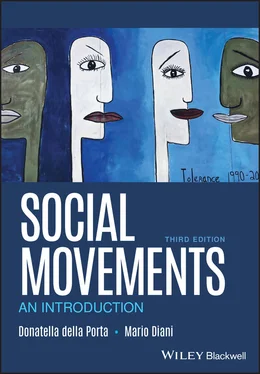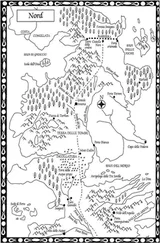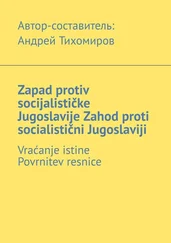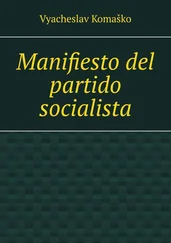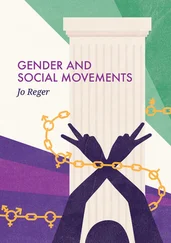1 ...8 9 10 12 13 14 ...28 Collective identity building also entails actors establishing connections between different occurrences, private and public, located at different points in time and space, which are relevant to their experience, and weaving them in broader, encompassing narratives (Melucci 1996; Tilly 2005). As a result, organizational and individual actors involved in collective action no longer merely pursue specific goals, but come to regard themselves as elements of much larger and encompassing processes of change – or resistance to change. For example, in 2011, participants in events as distant as the Indignados square occupations in Spain and the anti‐government protests in Tunisia or Egypt might have felt to be linked together through processes of identity building based upon the shared call for greater democracy and supranational communication. Within social movements, membership criteria are extremely unstable and ultimately dependent on mutual recognition between actors; the activity of boundary definition – i.e., of defining who is and who is not part of the network – indeed plays a central role in the emergence and shaping of collective action (Melucci 1996, ch.3).
Looking at different combinations of these three elements enables us to contrast social movements to other collective action processes. Here we provide a few examples; however, we have to keep in mind that no empirical episode of collective action – those that we conventionally define as environmental movements, solidarity movements, disabled movements, or the like – fully corresponds to any pure type. To the contrary, we can normally detect more than one process within any empirical instance of collective action. The exploration of how such processes interact with each other represents a fundamental step of social movement analysis.
1.2.2 Conflictual and Consensual Collective Action
It is not rare to witness broad coalitions of charities and other voluntary associations mobilizing on solidarity issues, such as on social exclusion in domestic politics, or on development or human rights issues in an international perspective, and to refer to them as social movements. In many cases, however, they might be best characterized as consensus movements . In both social movement and consensus movement dynamics, actors share solidarity and an interpretation of the world, enabling them to link specific acts and events in a longer time perspective. However, in the latter sustained collective action does not take a conflictual element. Collective goods are often produced through cooperative efforts that neither imply nor require the identification of specific adversaries, trying to reduce the assets and opportunities of one’s group or preventing chances to expand them. Prospected solutions do not imply redistribution of power nor alterations in social structure but focus instead on service delivery, self‐help, and personal and community empowerment. Likewise, the practice and promotion of alternative lifestyles need not the presence of opponents defined in social and political terms. Collective actors may fight ethereal adversaries, ranging from bad or conventional taste, in the case of artistic and style‐oriented movements, to “the inner enemy,” in the case of some religious movements, without necessarily blaming any social actors for the state of things they intend to modify.
However, insisting on the presence of conflict as a distinctive trait of movements need not force social movement analysts away from the investigation of those instances of collective action where a conflict is difficult to identify, such as those oriented to personal change (e.g. the human potential movement , or many countercultural, alternative lifestyle networks) and those focusing on the delivery of some kind of help or assistance to an aggrieved collectivity (e.g., solidarity movements: Giugni and Passy 2001; Brown and Yaffe 2013). This perspective implies, instead, that analysts recognize the presence of several social mechanisms or dynamics within each instance of collective action, and focus their efforts on exploring how such mechanisms operate and interact with each other.
1.2.3 Social Movements, Events, and Coalitions
We have a social movement dynamic going on when single episodes of collective action are perceived as components of a longer‐lasting action, rather than discrete events; and when those who are engaged in them feel linked by ties of solidarity and of ideal communion with protagonists of other analogous mobilizations. Identity building also means that a sense of collective belonging can be maintained even after a specific initiative or a particular campaign has come to an end. The persistence of these feelings will have at least two important consequences. First, it will make the revival of mobilization in relation to the same goals easier, whenever favorable conditions recur. Movements often oscillate between brief phases of intense public activity and long latent periods (Melucci 1996) in which self‐reflection and cultural production prevail. The trust and solidarity links, activated in the European antinuclear movements during the mobilizations of the second half of the 1970s, for example, represented the base on which a new wave of protests gathered momentum in the wake of the Chernobyl incident in 1986 (Flam 1994a). Second, representations of the world and collective identities that developed in a certain period can also facilitate, through a gradual transformation, the development of new movements and new solidarities. For example, the close relationship existing in several countries between different waves of activism has been noted on a number of occasions (Dalton 2008; Grasso 2016; della Porta 2018b).
Reference to other examples of informal networks of collective action, such as coalitions, also illustrates why collective identity is such a crucial feature of social movements. In coalition dynamics, collective actors are densely connected to each other in terms of alliances, and identify explicit opponents, but those links are not necessarily backed by strong identity links. The networks between actors mobilizing on a common goal take a purely contingent and instrumental nature. Resource mobilization and campaigning is then conducted mainly through exchanges and pooling of resources between distinct groups and organizations. The latter rather than the network are the main source of participants’ identities and loyalties. Actors instrumentally share resources in order to achieve specific goals, yet do not develop any particular sense of belonging and of common future during the process. Once a specific battle has been fought, there need not be any longer term legacy in terms of identity and solidarity, nor attempts to connect the specific campaign in a broader framework (see e.g. Lemieux 1997, 1998). Of course, nothing prevents a coalitional dynamic from evolving into a social movement one, but it is still important to recognize the analytical difference between the two processes (Diani 2015).
It is worth stressing that associating movements to a distinctive collective identity implies no assumptions about the homogeneity of the actors sharing that identity. We have a social movement identity dynamic to the extent that groups and/or individuals feel part of a collectivity, mobilized to support or oppose social change; that they identify shared elements in their past, present, and future experiences; and that other social or political actors be held responsible for the state of affairs being challenged. Whether a specific collective identity will be inclusive or exclusive, and the degree to which holders of such identity will share one or several traits, is an empirical question (see chapter 4).
1.2.4 Social Movements and Organizational Processes
Читать дальше
